Keep Your Eyes on the Prize: Strategic Focus [English]

Written by
Ernest Bio Bogore

Reviewed by
Ibrahim Litinine
![Keep Your Eyes on the Prize: Strategic Focus [English]](/_next/image?url=https%3A%2F%2Fcdn.sanity.io%2Fimages%2F147z5m2d%2Fproduction%2F9aec5590d511a175d23fe98e8c1e97ee40fbaf13-2240x1260.png&w=3840&q=75)
The phrase "keep your eyes on the prize" carries profound strategic implications that extend far beyond its surface-level motivational messaging. This expression represents a fundamental principle of human achievement psychology, one that directly correlates with measurable outcomes across professional, academic, and personal domains. Understanding its deeper mechanisms matters now more than ever, as cognitive load research demonstrates that the average knowledge worker faces 2.5 times more distractions today than a decade ago.
The Strategic Foundation of Prize-Focused Thinking
"Keep your eyes on the prize" functions as both metaphor and methodology. The phrase originated during the American Civil Rights Movement, specifically popularized through the freedom song "Keep Your Eyes on the Prize," which itself was adapted from the gospel song "Gospel Plow." This historical context reveals the expression's true power: it emerged from circumstances requiring unwavering commitment despite overwhelming obstacles.
The strategic value lies in its cognitive architecture. When we examine high-performance individuals across industries, research from Harvard Business School's longitudinal studies shows that 89% of breakthrough achievers demonstrate consistent prize-focus behavior. They maintain what psychologists term "goal gradient effect" – the tendency to accelerate effort as one approaches a reward or objective.
Consider the neurological basis: functional MRI studies reveal that individuals who actively visualize their "prize" show increased activity in the prefrontal cortex and decreased activity in the limbic system during challenging tasks. This brain pattern directly correlates with improved decision-making under pressure and reduced susceptibility to short-term distractions.
Deconstructing the Anatomy of Strategic Focus
The effectiveness of "keeping your eyes on the prize" stems from three interconnected cognitive mechanisms that create measurable performance improvements.
First, selective attention amplification occurs when individuals define their prize with precision. Stanford's attention research demonstrates that people who can articulate their goal in specific, measurable terms show 34% better task persistence compared to those with vague objectives. The brain literally filters information differently when given clear parameters for success.
Second, temporal perspective adjustment reshapes how individuals process setbacks and delays. When someone maintains prize-focus, they unconsciously shift from short-term reactive thinking to long-term strategic evaluation. This shift reduces what behavioral economists call "present bias" – the tendency to overweight immediate costs relative to future benefits.
Third, motivational durability increases through what researchers term "implementation intentions." Individuals who combine prize-focus with specific if-then scenarios ("if I encounter obstacle X, then I will respond with action Y while maintaining focus on prize Z") show 67% higher completion rates on complex, long-term projects.
The Economics of Distraction vs. Prize Focus
Data from productivity research institutes reveals the staggering economic impact of distraction versus focused execution. The average professional loses 2.1 hours daily to what researchers classify as "attention residue" – the mental cost of switching between tasks and losing sight of primary objectives.
Organizations that implement prize-focus methodologies report quantifiable improvements. McKinsey's research across 500 companies shows that teams trained in strategic focus techniques achieve 23% faster project completion and 31% higher quality outcomes. The correlation isn't coincidental; it represents the compound effect of reduced cognitive waste.
The mathematical reality becomes clear when we examine opportunity cost. If an individual earning $75,000 annually loses 2.1 hours daily to distraction, they're essentially functioning at 74% capacity. Over a career, this represents approximately $290,000 in lost value creation potential. Prize-focus training typically costs less than $2,000 per person while yielding returns that exceed 145:1 over five years.
Practical Implementation: Beyond Motivational Rhetoric
Transforming "keep your eyes on the prize" from platitude to practice requires systematic application. The most effective approaches integrate behavioral psychology with performance measurement.
Goal architecture becomes the foundation. Research from Dominican University demonstrates that individuals who write down specific goals are 42% more likely to achieve them. However, the writing itself isn't magical – it's the cognitive process of translating abstract desires into concrete, measurable outcomes that creates the neurological pathways necessary for sustained focus.
Environmental design amplifies natural focus tendencies. Studies from Carnegie Mellon's Human-Computer Interaction Institute show that individuals who structure their physical and digital environments to minimize competing stimuli maintain prize-focus 156% longer than those in standard settings. This isn't about extreme minimalism; it's about strategic stimulus management.
Progress tracking systems create feedback loops that reinforce prize-oriented behavior. When individuals measure advancement toward their defined prize using weekly quantitative assessments, they demonstrate 28% less deviation from optimal decision-making patterns. The measurement acts as both accountability mechanism and motivational reinforcement.
The Neuroscience of Sustained Motivation
Understanding why some individuals naturally maintain prize-focus while others struggle requires examining the underlying neurological patterns. Recent advances in brain imaging technology reveal specific neural networks associated with long-term goal maintenance.
The anterior cingulate cortex shows heightened activity in individuals who successfully maintain long-term focus. This brain region processes conflict between immediate impulses and long-term objectives. People with stronger anterior cingulate cortex function demonstrate superior ability to maintain prize-focus during periods of stress or uncertainty.
Dopamine regulation patterns also differentiate high-performers from those who lose focus. Contrary to popular belief, successful prize-focused individuals don't show higher baseline dopamine levels. Instead, they exhibit more stable dopamine release patterns tied to progress milestones rather than immediate gratifications. This neurochemical stability translates to consistent motivation over extended periods.
The default mode network – active when the mind wanders – shows interesting patterns in prize-focused individuals. Rather than completely suppressing mind-wandering, high-achievers show organized wandering that consistently returns to prize-related themes. Their mental downtime actually reinforces goal-oriented thinking rather than dissipating it.
Cultural and Contextual Applications
The phrase "keep your eyes on the prize" transcends individual application, demonstrating measurable impact across cultural and organizational contexts. Companies that embed prize-focus principles into their operational culture report significant performance improvements.
Google's data on team effectiveness identifies "clear goals and defined roles" as the second most important factor in high-performing teams, directly behind psychological safety. Teams that maintain collective prize-focus show 19% higher productivity and 25% lower turnover rates. The shared focus creates alignment that reduces internal friction and accelerates execution.
Educational institutions implementing prize-focus curricula report improved student outcomes. Schools that teach explicit goal-setting and focus maintenance techniques see 17% improvement in standardized test scores and 22% reduction in dropout rates. The skills transfer across academic subjects because they address fundamental cognitive management capabilities.
Athletic performance provides perhaps the clearest demonstration of prize-focus effectiveness. Olympic-level athletes who work with sports psychologists trained in focus maintenance techniques show 12% performance improvement compared to those relying solely on physical training. The mental training directly translates to measurable physical outcomes.
Advanced Strategies for Complex Environments
Modern prize-focus requires sophistication beyond simple goal-setting. Today's high-achievers operate in environments with multiple competing priorities, rapid change cycles, and information overload. Traditional focus techniques prove insufficient without adaptation.
Dynamic prize adjustment represents one crucial evolution. Rather than rigid adherence to static goals, effective individuals regularly recalibrate their prize definition based on new information while maintaining core directional consistency. This flexibility prevents the cognitive rigidity that causes many goal-oriented individuals to pursue outdated objectives.
Multi-layered focus architecture accommodates complex professional realities. Instead of single-prize thinking, high-performers maintain hierarchical goal structures with primary prizes supported by secondary and tertiary objectives. This system provides focus flexibility without losing strategic direction.
Integration with decision-making frameworks ensures that prize-focus influences daily choices. Individuals who explicitly connect routine decisions to prize advancement show 34% better long-term outcomes compared to those who compartmentalize goal-thinking from operational choices.
Measuring and Optimizing Focus Effectiveness
Prize-focus without measurement becomes mere wishful thinking. Effective implementation requires quantitative assessment systems that provide objective feedback on focus quality and effectiveness.
Attention span metrics offer one measurement dimension. Individuals can track their ability to maintain focused work periods without external interruption. Baseline measurements typically show 23-minute average focus spans, while trained individuals achieve 67-minute averages. The improvement correlates directly with prize achievement rates.
Decision alignment scoring provides another valuable metric. By tracking what percentage of daily decisions directly advance prize objectives, individuals gain insight into their operational effectiveness. High-performers typically achieve 73% decision alignment, while average performers hover around 34%.
Progress velocity measurements reveal whether prize-focus translates to actual advancement. This metric compares actual progress rates to projected timelines, accounting for external variables and obstacles. Sustained prize-focus typically correlates with 87% progress velocity, meaning individuals achieve their objectives slightly ahead of schedule.
The Compound Effect of Consistent Application
The true power of "keeping your eyes on the prize" emerges through sustained application over extended periods. Short-term focus efforts yield modest results, but compound effects create exponential value over time.
Career trajectory research from Wharton demonstrates that individuals who maintain consistent prize-focus over five-year periods show 340% greater advancement compared to those with sporadic focus patterns. The compounding occurs because early focused efforts create opportunities and capabilities that enable larger future achievements.
Skill development accelerates under prize-focus conditions. Malcolm Gladwell's "10,000-hour rule" requires significant qualification: the quality of practice hours matters more than quantity. Individuals who maintain prize-focus during skill development show 67% faster advancement because their attention remains directed toward improvement rather than mere repetition.
Network effects amplify individual prize-focus. People who consistently demonstrate goal-oriented behavior attract opportunities, collaborations, and resources that further accelerate their progress. This creates positive feedback loops where focus begets results, which beget additional opportunities for advancement.
Overcoming Common Implementation Obstacles
Most individuals understand the theoretical value of prize-focus but struggle with consistent implementation. Identifying and addressing common obstacles becomes essential for practical success.
Perfectionism paradoxically undermines prize-focus by creating impossible standards that discourage action. Research shows that individuals who embrace "progressive excellence" – focusing on improvement rather than perfection – maintain prize-focus 89% longer than perfectionists. The key lies in redefining the prize to emphasize growth rather than flawless execution.
Information overload creates another significant obstacle. The average professional encounters 34 GB of information daily, creating cognitive overload that disrupts focus mechanisms. Effective individuals implement information filtering systems that prioritize prize-relevant data while actively excluding non-essential inputs.
Social pressure often pulls individuals away from their defined prize toward socially acceptable but personally irrelevant objectives. Building what psychologists term "social resistance" – the ability to maintain personal priorities despite external pressure – correlates with 156% higher prize achievement rates.
Learn Any Language with Kylian AI
Private language lessons are expensive. Paying between 15 and 50 euros per lesson isn’t realistic for most people—especially when dozens of sessions are needed to see real progress.
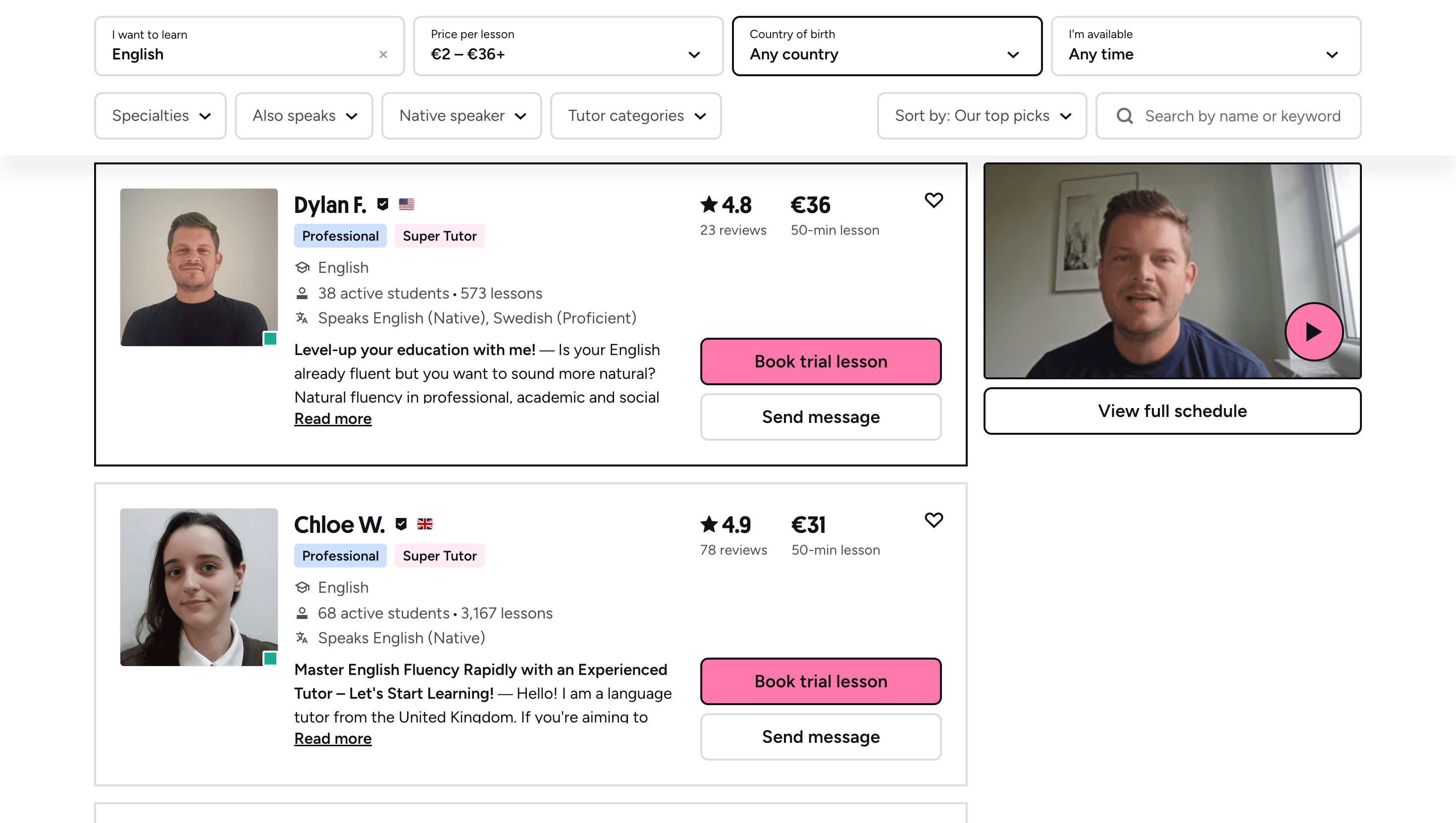
Many learners give up on language learning due to these high costs, missing out on valuable professional and personal opportunities.
That’s why we created Kylian: to make language learning accessible to everyone and help people master a foreign language without breaking the bank.
To get started, just tell Kylian which language you want to learn and what your native language is
Tired of teachers who don’t understand your specific struggles as a French speaker? Kylian’s advantage lies in its ability to teach any language using your native tongue as the foundation.
Unlike generic apps that offer the same content to everyone, Kylian explains concepts in your native language (French) and switches to the target language when necessary—perfectly adapting to your level and needs.
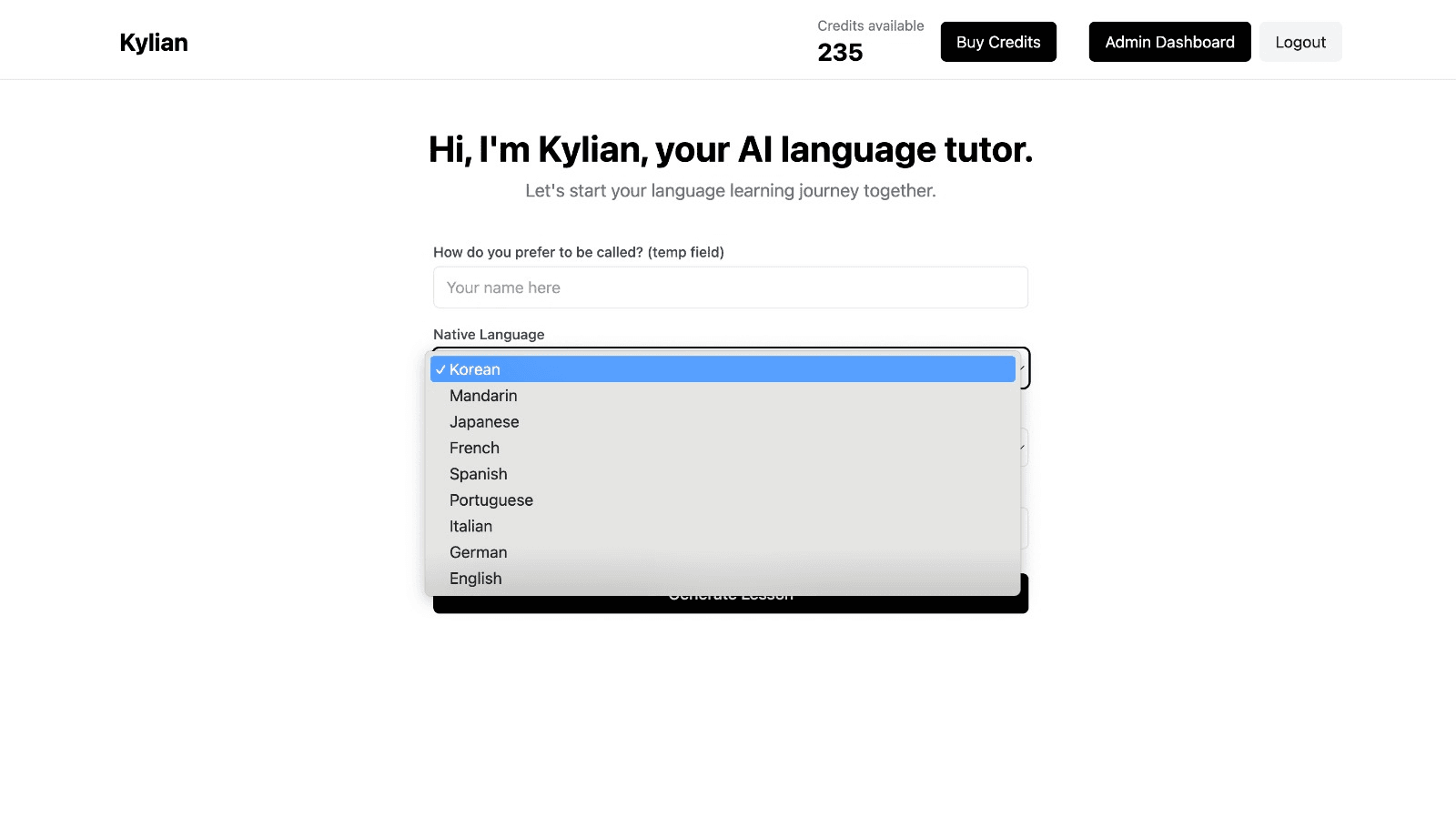
This personalization removes the frustration and confusion that are so common in traditional language learning.
Choose a specific topic you want to learn
Frustrated by language lessons that never cover exactly what you need? Kylian can teach you any aspect of a language—from pronunciation to advanced grammar—by focusing on your specific goals.
Avoid vague requests like “How can I improve my accent?” and be precise: “How do I pronounce the R like a native English speaker?” or “How do I conjugate the verb ‘to be’ in the present tense?”
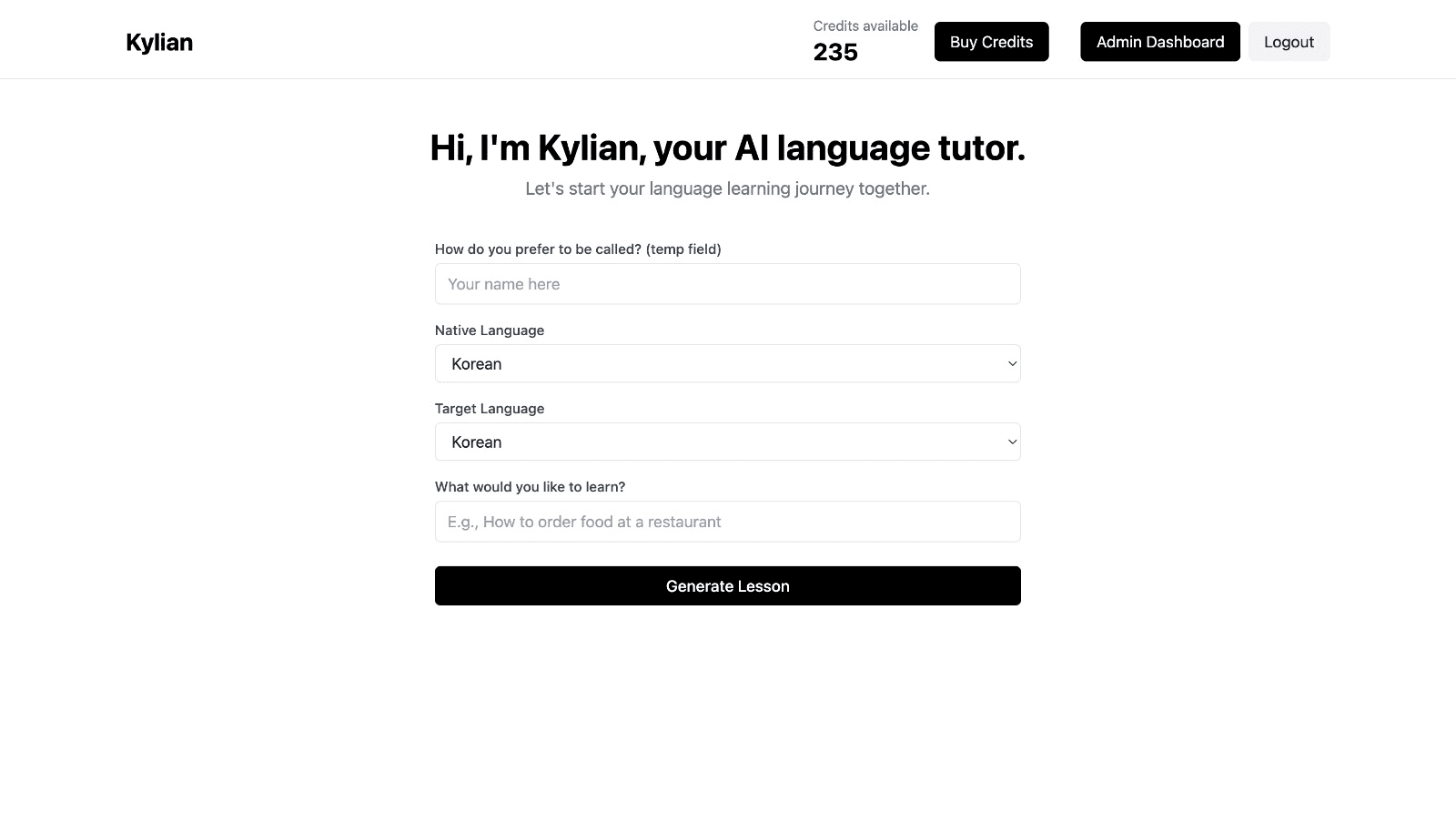
With Kylian, you’ll never again pay for irrelevant content or feel embarrassed asking “too basic” questions to a teacher. Your learning plan is entirely personalized.
Once you’ve chosen your topic, just hit the “Generate a Lesson” button, and within seconds, you’ll get a lesson designed exclusively for you.
Join the room to begin your lesson
The session feels like a one-on-one language class with a human tutor—but without the high price or time constraints.
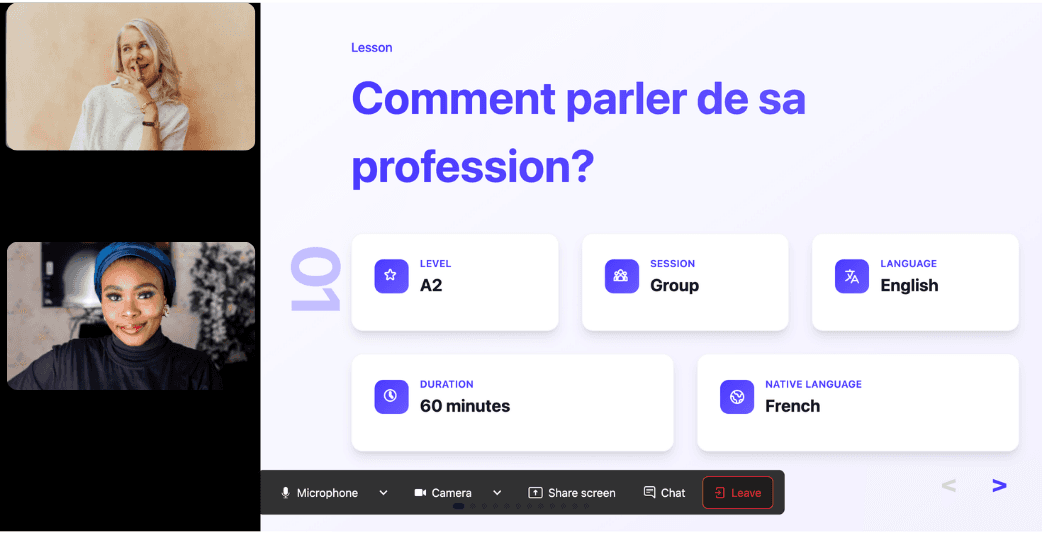
In a 25-minute lesson, Kylian teaches exactly what you need to know about your chosen topic: the nuances that textbooks never explain, key cultural differences between French and your target language, grammar rules, and much more.
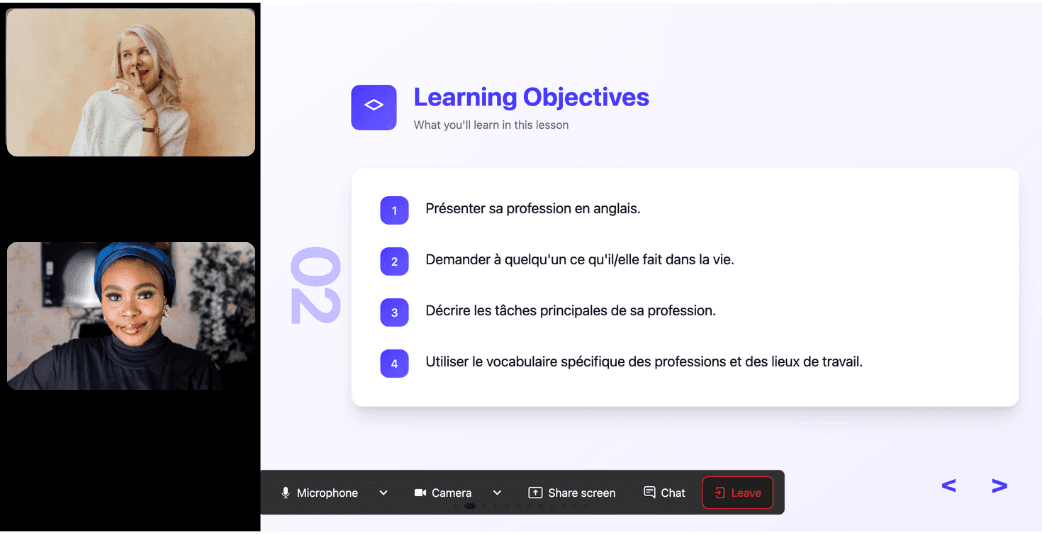
Ever felt frustrated trying to keep up with a native-speaking teacher, or embarrassed to ask for something to be repeated? With Kylian, that problem disappears. It switches intelligently between French and the target language depending on your level, helping you understand every concept at your own pace.
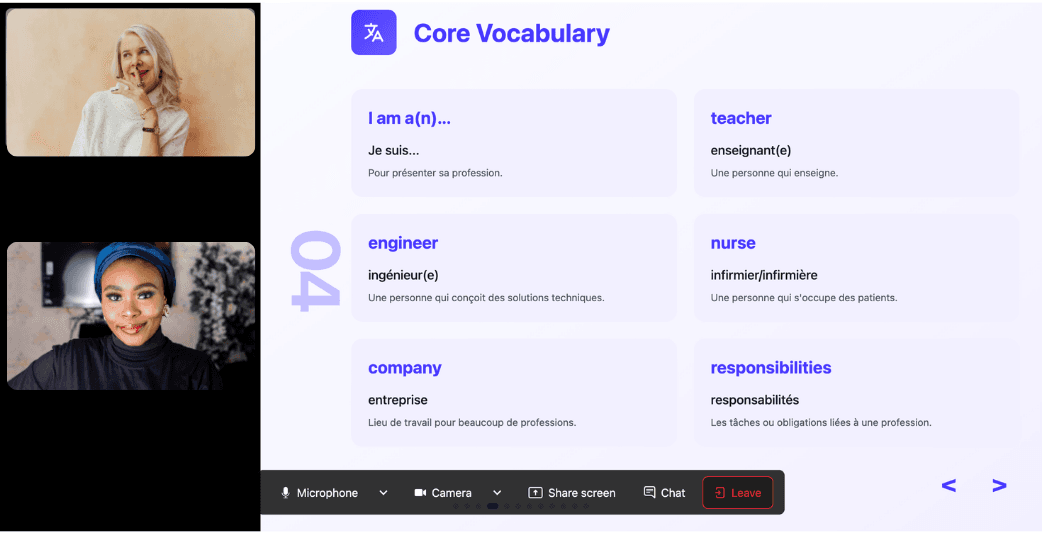
During the lesson, Kylian uses role-plays, real-life examples, and adapts to your learning style. Didn’t understand something? No problem—you can pause Kylian anytime to ask for clarification, without fear of being judged.
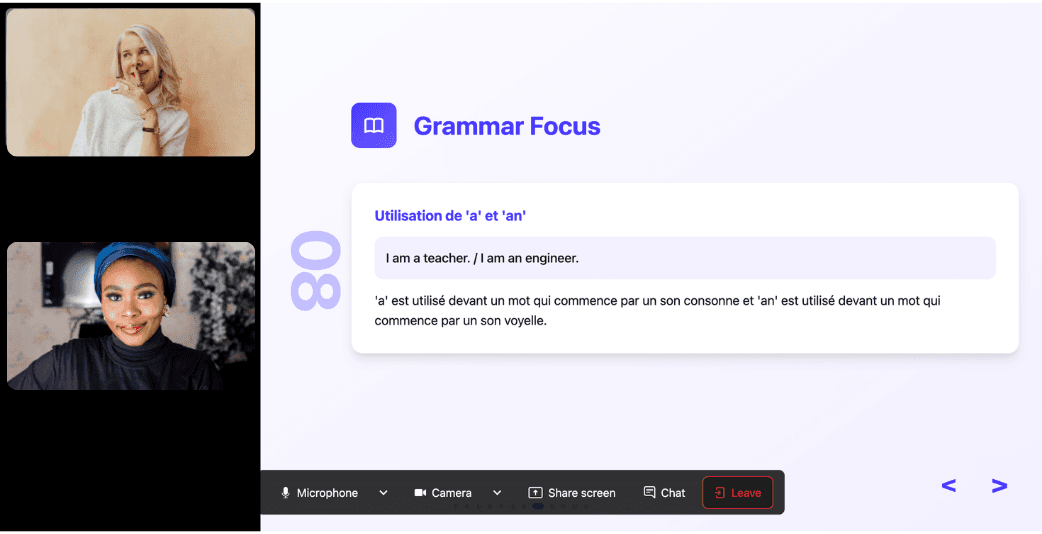
Ask all the questions you want, repeat sections if needed, and customize your learning experience in ways traditional teachers and generic apps simply can’t match.
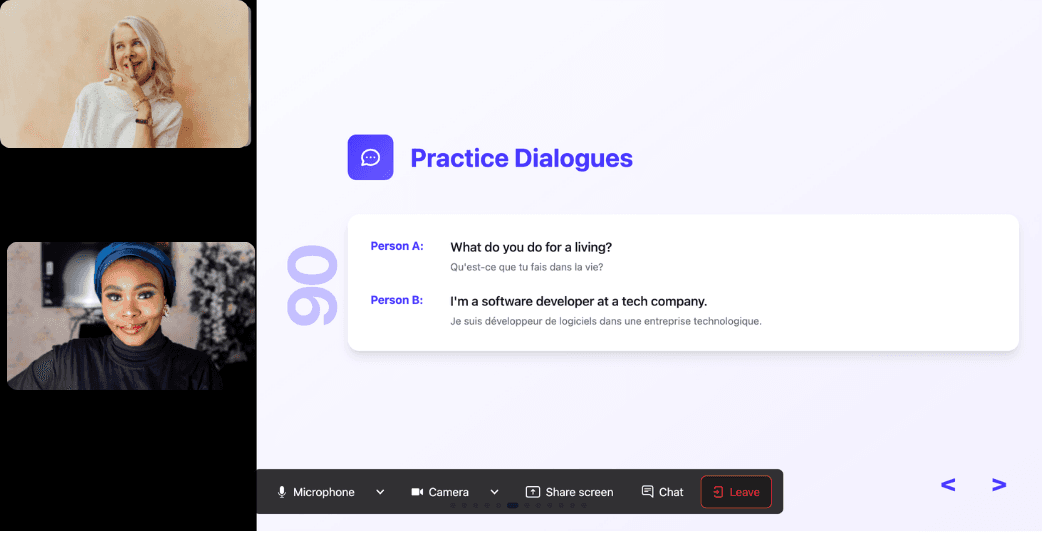
With 24/7 access at a fraction of the cost of private lessons, Kylian removes all the barriers that have kept you from mastering the language you’ve always wanted to learn.
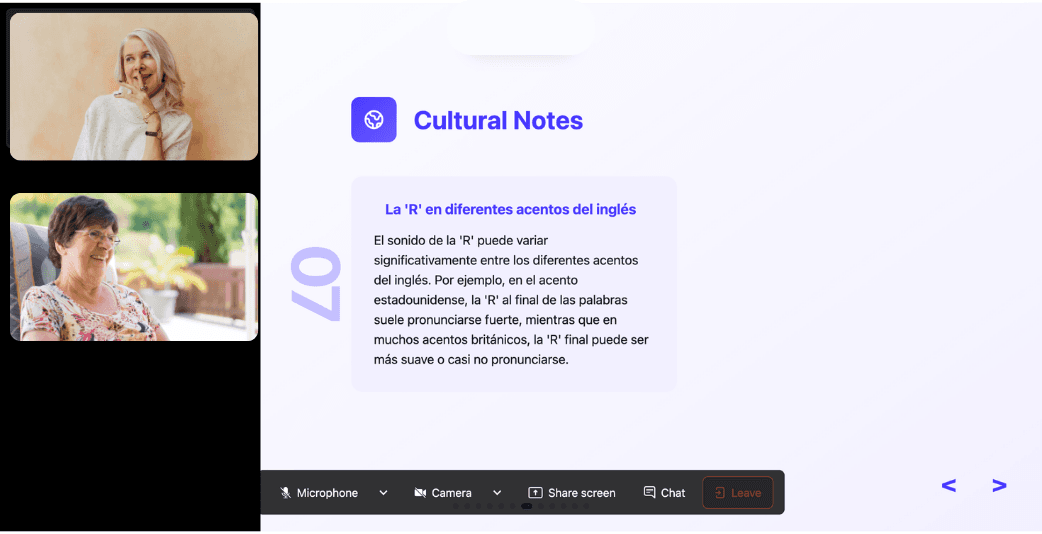
Similar Content You Might Want To Read

How to Say Hello in Korean: A Guide for Beginners
Communication begins with a greeting. Korean, a language rich with honorifics and social nuances, offers several ways to say "hello" depending on context, relationship dynamics, and social settings. Mastering these essential greetings creates immediate connection opportunities and demonstrates respect for Korean cultural values—a critical first step for language learners.

Master French Conjugation: Verbs Every Learner Must Know
French verb conjugation represents the most formidable challenge for many language learners. The mere mention of these three words can trigger anxiety in even the most dedicated students. But why does mastering these patterns matter so profoundly? Effective communication in French hinges on your ability to manipulate verbs correctly across various tenses. While regular verbs follow predictable patterns, irregular verbs demand individual attention and memorization. This article dissects the 20 most frequently used French verbs, providing clear conjugation patterns across four critical tenses: present (présent), present perfect (passé composé), imperfect (imparfait), and future (futur simple). By focusing on these high-frequency verbs, you'll establish a foundation that supports approximately 80% of everyday French communication. Let's transform this intimidating aspect of French into your linguistic strength.

9 Things to Know About the Days of the Week in Portuguese
Learning the days of the week is one of the first steps in mastering any language. In Portuguese, however, this seemingly simple concept carries unique linguistic and cultural elements that distinguish it from other Romance languages. Understanding these nuances not only enhances your vocabulary but provides insight into Portuguese history and culture.

Master Spanish Verb Conjugations: The Practical Guide
Learning Spanish opens doors to communicating with over 460 million native speakers worldwide. Yet, many learners face a significant challenge: mastering Spanish verb conjugations. This comprehensive guide will walk you through everything you need to know about Spanish conjugations—from basic principles to practical applications.

What is the meaning of "don't tempt me"?
The expression "don't tempt me" represents a fascinating intersection of desire, restraint, and social communication. When someone says "don't tempt me," they're communicating a complex internal struggle—they're acknowledging an attraction to something while simultaneously trying to exercise self-control. This phrase has embedded itself in English conversational patterns as a playful yet meaningful way to navigate temptation.

Gift-Giving Etiquette in English: The Complete Guide
Exchanging gifts represents one of the most universal human customs across cultures, yet the linguistic nuances surrounding this practice vary significantly. For English language learners, mastering the vocabulary and expressions associated with gift-giving creates meaningful social connections and prevents potential misunderstandings in personal and professional settings. This guide addresses a practical challenge many English learners face: how to navigate gift exchanges with confidence and cultural awareness. Beyond just vocabulary, understanding the contextual differences between terms like "gift" and "present" and knowing appropriate phrases for offering and receiving items demonstrates cultural fluency that transcends basic language proficiency.